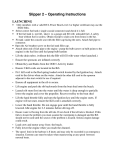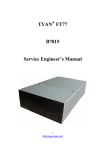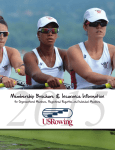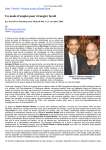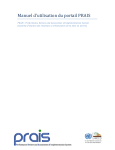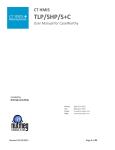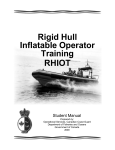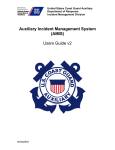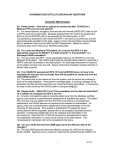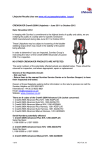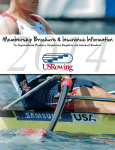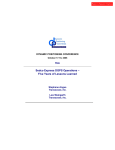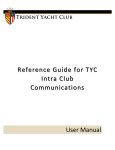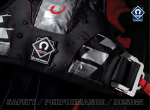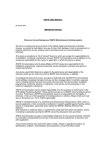Download Rowing Ireland Safety Document 2012
Transcript
Safety Document Rowing Ireland Safety Document Introduction Safety has become an increasingly important issue in sport and in our daily lives. Rowing is a safe sport when conducted with due consideration for the risks inherently associated with any outdoor water sport. The purpose of this document is to provide guidance and direction to rowing clubs affiliated to Rowing Ireland and to organisers of rowing events under the auspices of Rowing Ireland. The document contains best practice guidelines for clubs and event organisers. All decisions regarding safety at rowing clubs and rowing events should be based on risk management as no safety document can possibly cover all situations. By continually assessing likely risks and taking action to manage them, some generalised standards can be developed, enabling us to provide guidance on how to avoid and take action regarding unforeseen hazardous situations. The key elements in a risk management process are; a balanced assessment of risks in advance, the communication to club or competition members on how to take action to limit these risks and direction on how to cope with hazards when they occur. A policy of risk management also requires a review of system failures and any necessary re-shaping of guidance and rules in the light of the experience gained. All clubs have a responsibility to provide information, education and training about safety to their members. Individual members also have a responsibility to find out, learn, question and implement safety best practice. Having safety in mind at all times is an important part of what it means to be a club member. This document is not meant as an all-inclusive treatment of rowing safety, as all possible situations and types of rowing could not be effectively covered in such a publication. However, the guidelines contained in the document should serve as an outline for clubs and event organisers in drafting and implementing their own safety program. The document is presented in two main sections: Safety Requirements (i.e. “must do” activities) and Safety Recommendations (i.e. “should do” activities). Rowing Ireland Safety Document Contents 1. Safety Requirements: 1.1 1.2 1.3 1.4 1.5 Safety Audits (including Risk Assessment) Safety Equipment Safety Advisors Safety Statements Boats 2. Safety Recommendations: 2.1 2.2 2.3 2.4 2.5 2.6 Swim Test Capsize drills Launches Coach/Athlete Ratio First Aid Cardiopulmonary Resuscitation (CPR)/Defibrillators Appendix 1: Instructions For Safe Launch Driving Appendix 2: Lifejacket Care Appendix 3: General Water Safety Information Rowing Ireland Safety Document Safety Requirements 1.1 Safety Audits (including Risk Assessment) A Safety Audit is a method of evaluating and improving your safety plans and policies. It is a process by which a club (or event committee) examines its present policies and practices in terms of safety. The purpose of a safety audit is to highlight points of good practice and process regarding a club's (or event's) safety policies and practices. A safety audit also highlights gaps in practices and policies allowing for planning to fill these gaps. Clubs should conduct an overall safety audit annually. A separate safety audit should be conducted for each competition and event as they occur. Clubs/event organisers should act on recommendations received based on their safety audit. In a safety audit, comparisons should be made between current policies/practices and best practice guidelines contained in this document. For example, a Rowing Ireland safety guideline is that all coxswains must wear a lifejacket; therefore the question to ask your club is “do all our coxswains wear life jackets?” The audit is a simple means of reviewing your policy, finding any gaps, and identifying a means to address them. Risk Assessment is an important component of the safety audit. Risk assessment is a process which assists in estimating the overall level of risks relating to a club's activities or to an event. The assessment consists of estimating the seriousness of potential risks and measuring the likelihood of these risks occurring. A risk assessment measures what hazards are present, who may be harmed by them, and how this harm could occur. From this the level of risk is then calculated. A risk assessment must be undertaken in order to develop an accurate safety and emergency action plan. It is the responsibility of club officers (or event organisers) to ensure risk assessments are completed. Following risk assessment, a Risk Management process should be implemented to determine steps to mitigate assessed risk by taking actions to eliminate identified risks or to bring them to an acceptable level. The process involves assessing risk, identifying solutions and monitoring subsequent actions to see if they are successful in risk elimination or reduction. Findings are recorded, and the assessment and management process regularly reviewed and revised as appropriate. In Conducting a Risk Assessment it is best to use a structured process and format. On the following two pages are outlined a template and an example of template completion as a guide to a structured risk assessment process. In applying the template the following questions should be asked: 1. What hazards are present? 2. Who might be harmed? 3. How could they be harmed? 4. What is the likelihood of this occurring? 5. What precautions are in place? 6. Could precautions be improved? Risk Assessment Template Event: Location: Activities Covered by this Risk Assessment: Risk Assess ment No. Event Date: Identify hazards associated with each task step in terms of affecting production Outline what the risk has the potential to cause Initial Risk Rating See Likelihood and Severity Categories and Risk Matrix Below L S Risk Assessment Owner: Actions to reduce risk Rating a) Can the risk be avoided in so far as is reasonable practicable by changing the event conditions format, schedule? b) Can the risk be reduced in so far as is reasonable practicable by changing the event conditions, format, schedule or by provision of safety marshalling? c) If the final risk rating is still significant, explain why and what is required to minimize the risk. R Residual Risk Rating See Likelihood and Severity Categories and Risk Matrix Below L S Risk Status Complete = measures implemented Pre-Race = confirm in place prior to commencement Manage = Manage risk during event by adherence to safety plan & marshalling R 1. 2. 3. 4. Likelihood (L) 5 Certain or Near Certain Severity (S) Categories 5 4 Potential Fatality or Incapacitation Significant trauma or laceration injury due to Risk (R) Matrix Risk Acceptability High (H) Unacceptable, must reduce. Communicate Residual Risk if applicable. “Sample / Typical Rowing Related Risks” Non-Exhaustive list 4 Very Likely 3 Likely 2 Somewhat Likely 1 Unlikely 3 2 1 collision / extended exposure to adverse weather conditions Potential Immersion / exposure to adverse conditions Minor injury / equipment damage / crew loses opportunity to compete Minor disruption to event / crew disadvantaged Medium (M) Low (L) Tolerable, assuming risk has been reduced as far as “Reasonably Practicable”. Communicate Residual Risk Tolerable. Communicate Residual Risk. 1. 2. 3. 4. Immersion in cold water Drowning Injury – collisions or crashes Hypothermia – sustained exposure to adverse conditions or extended immersion 5. Injury while lifting / carrying equipment 6. Interface of cars / traffic with boats / trailers Risk Assessment Example Event: Location: Event Date: Risk Assessment Owner: Activities Covered by this Risk Assessment: Risk Asses sment No. Identify hazards associated with each task step in terms of affecting production Refer to “Sample Risks” outlined below. Outline what the risk has the potential to cause Initial Risk Rating See Likelihood and Severity Categories and Risk Matrix Below 5. Boat capsize while slipping, or approaching/leaving slip L 2 S 3 R M 6. Head on collision of racing boats 3 4 H 7. Boats while racing crash into fixed obstacles on river/ river bank 4 2 M 8. Spectator struck by boat or oars being carried to or from the slip 1 4 L Actions to reduce risk Rating d) Can the risk be avoided in so far as is reasonable practicable by changing the event conditions format, schedule? e) Can the risk be reduced in so far as is reasonable practicable by changing the event conditions, format, schedule or by provision of safety marshalling? f) If the final risk rating is still significant, explain why and what is required to minimize the risk. Ensure slips used by visiting crews are marshalled and slipping supervised Format of event ensures one way traffic only; all racing boats are above the start before each event starts Install guidance & warning buoys where possible in advance. Inform all steerers of the course, provide maps, safety Marshall coverage of entire racing course Marshalls to encourage spectators to keep slip area clear Residual Risk Rating See Likelihood and Severity Categories and Risk Matrix Below Risk Status Complete = measures implemented Pre-Race = confirm in place prior to commencement Manage = Manage risk during event by adherence to safety plan & marshalling L 1 S 3 R M 1 4 L Complete 3 2 L Pre-Race Manage 3 2 L Pre-Race Manage Complete Pre-Race Likelihood (L) 5 4 3 2 1 Certain or Near Certain Very Likely Likely Somewhat Likely Unlikely Severity (S) Categories 5 4 3 2 1 Potential Fatality or Incapacitation Significant trauma or laceration injury due to collision / extended exposure to adverse weather conditions Potential Immersion / exposure to adverse conditions Minor injury / equipment damage / crew loses opportunity to compete Minor disruption to event / crew disadvantaged Risk (R) Matrix Risk Acceptability High (H) Medium (M) Low (L) Unacceptable, must reduce. Communicate Residual Risk if applicable. Tolerable, assuming risk has been reduced as far as “Reasonably Practicable”. Communicate Residual Risk Tolerable. Communicate Residual Risk. “Sample / Typical Rowing Related Risks” Non-Exhaustive list 7. Immersion in cold water 8. Drowning 9. Injury – collisions or crashes 10. Hypothermia – sustained exposure to adverse conditions or extended immersion 11. Injury while lifting / carrying equipment 12. Interface of cars / traffic with boats / trailers Rowing Ireland Safety Document Safety Requirements 1.2 Safety Equipment Safety and first aid equipment should be readily available at all club houses and for all organised events such as camps, trials and competitions. All clubs should have written instructions readily available on how to use safety equipment effectively and efficiently. Equipment should include: First Aid Kit (see Section 2.5 below) Lifejackets - which should be checked regularly for wear and tear. A maintenance log solely for lifejackets should be kept by clubs. Lifejackets must conform to European Standards (EN) (http://www.safety-marine.co.uk/spages/how-to-choose-a-lifejacket.htm) and carry a CE mark, this is in adherence with Irish Law and European Law. All coxswains must wear an approved lifejacket both in competition and in training. In the case where the coxswain is located in the bow of a boat, care must be taken in the choice of lifejacket to ensure that the coxswain's fast exit from the boat is not restricted. Coach Equipment (On Land): Coaches who coach on bike or foot should carry appropriate safety equipment such as a throw bag and a basic safety kit. Safety Boat Equipment: The safety boat is also often the coach boat. However, the term safety boat means that the boat has the designated purpose of ensuring safety on the water and should carry the following equipment: A bailer A sound signalling warning device. A sharp knife in carrying sheath (to cut free from tangled ropes or weeds) A paddle. Anchor and line. First aid kit Thermal blankets A throw bag Life buoys For inflatable rubber dinghies, a spare inflation valve and a hand pump. Rowing Ireland Safety Document Safety Requirements 1.3 Safety Advisors Every club should appoint a safety advisor. The safety advisor’s role is to ensure an appropriate safety program is developed in accordance with best practice guidelines such as those provided in the Rowing Ireland Safety Document. The safety advisor must be familiar with the club’s safety policies and practices, with the Rowing Ireland guidelines and with national safety policies and regulations. He/she has a duty to promote safety in their club, but is not the only person in the club responsible for safety. The safety advisor is the person who advises on safety issues but ensures that the responsibility for implementing safety practices remains with the club officers, committee and members. He/she should maintain the accident and incident log book ensuring that it is completed by those involved in incidents and that it is reviewed by the club officers/committee at regular intervals. Rowing Ireland Safety Document Safety Requirements 1.4 Safety Statements A safety statement contains the details of the club's (or event's) safety policy. The purpose of the safety statement is to outline the safety programme of the club or that applying to a particular event. Rowing Ireland strongly advises that all clubs and event organisers develop safety statements based on the responsibilities and guidelines contained in the Rowing Ireland Safety Document. Rowing Ireland Safety Document Safety Requirements 1.5 Boats As a water based sport, there are always risks to the safety of those who participate in rowing. Through good boat design and the implementation of safe practice, the risks that participants are exposed to are minimised. As rowing equipment ages however, some of the essential safeguards that are inherent in the original design of the boats and fittings degrade. It is critical that when this happens remedial action is taken to ensure that all boats are fit for purpose and do not present a risk to their occupants or other water users. There are three main areas where it is critical that constant preventative maintenance is carried out to ensure boats are safe to use. They are: Bow Balls Heel Restraints Hatch Covers The following pages illustrate what coaches, club captains, rowers and event officials need to watch for regarding these areas. During the rowing season event organisers should inspect equipment as it is launched to ensure that all equipment is safe. Under no circumstances should defective equipment be allowed to take to the water. Bow Balls There for Safety Reasons! Must fit properly Must be firmly secured Must not be torn, cracked or perished Look what is underneath a Bow Ball! Well fitting Bow Ball – Acceptable Bow Ball is only taped on – Not Acceptable Bow Ball only taped on – Not Acceptable Bow Ball starting to crack – Not Acceptable Bow Ball cracked and perished – Not Acceptable Bow Ball not secured – Not Acceptable Heel Restraints There for Safety Reasons! Do a visual check to make sure they are secured properly – yo-yo is a no-no ! Check each shoe independently Give each sharp tug to make sure they don’t break Don’t feel bad about breaking a restraint – you might have just saved a life ! Heel restraints properly and individually secured – Acceptable Heel restraints properly tied in - Acceptable No Heel restraint strings tied– Not Acceptable Yo-yo is a No-no ! – Not Acceptable Heel Restraint not tied – Not Acceptable No clips for Heel Restraint – Not Acceptable Hatch Covers There for Safety Reasons! Prevent buoyancy compartments from taking water Make sure they are in place Make sure they are fitted and sealed properly Types of Hatch Covers Hatch cover only taped over – Not Acceptable Rowing Ireland Safety Document Safety Recommendations 1.6 Swim Tests Rowers should be instructed to stay with their boats in the event of an accident. However all members of a rowing club should be able to demonstrate that they are confident and competent swimmers and it is the duty of the club to ensure that adequate swim tests are carried out for new members. Swim Tests should include: • Swimming for at least 50 meters in light clothing (rowing gear) • Threading water for at least two minutes • Swimming under water for at least 5 meters Members who cannot complete the above and do not demonstrate any confidence and competence in and under water are required to wear a personal flotation device whilst rowing or have one stored in the boat with them. Swimming ability of members should be reassessed and documented at appropriate intervals. Rowing Ireland Safety Document Safety Recommendations 1.7 Capsize Drills If a boat capsizes rowers must be instructed to stay with the boat, no matter what their swimming ability, as the boat can be used as a life raft (unless damage is too severe). Clubs should hold annual capsize training - ideally in a safe setting such as a local swimming pool. Activities which should be practised are: • Getting back into the boat • Getting on top of the boat • Lying on top of and paddling the boat • Summoning help • The buddy system of rescue • Recovery using throw-lines Rowers should learn the reasons why boats turn over or get swamped in order to enable them to take precautions. Rowers should also be given education on the effects of water temperatures, water conditions and clothing in different situations. They should understand that it is vital to get out of the water quickly (e.g. get on top of the boat) to reduce heat loss. Attendance at capsize drills should be documented. Rowing Ireland Safety Document Safety Recommendations 1.8 Launch Drivers Launches must carry the safety/emergency equipment (as outlined above in the safety equipment section) at all times. In addition best practice safety boat management requires that drivers should ensure that the launch: Is quick, manoeuvrable and stable and does not create excessive wash Has simple handholds fixed to the side to give help to any person being rescued and provide self-help should the driver fall overboard. Has adequate space to lie down a victim Has a plate stating the maximum weight it can support, translated into number of adults. Has propeller guards Where fitted with a kill switch that this is attached to the driver Has appropriate and regular maintenance checks on boats and engines. (A boat maintenance log should be kept for each launch showing maintenance and repairs for the boat, equipment and motor and the date when the work was carried out). If used after dark, is fitted with lights as laid down in the International Prevention of Collision Regulations or as prescribed by the appropriate navigation authority. (http://inoa.net/zeilen/colreg.html) (See Rule 22) Has easy entry to and from the water Launch drivers themselves must adhere to best practice safety behaviour by: Carrying an appropriate form of communication device and knowing emergency frequencies and numbers. Being aware of rules of the water. Wearing lifejackets at all times. Being trained in boat handling and rescue techniques. Ideally being certified in first aid Practicing and recording rescue techniques. Rowing Ireland Safety Document Safety Recommendations 1.9 Coach/Athlete Ratio The Coach/Athlete ratio needs to be considered from a safety viewpoint. The correct ratio depends on a number of factors such as: the experience level of the coach and the rowers, the weather conditions, the type of training session, the type and number of boats being used, the venue (i.e. whether a canal, a river, an open lake or a tidal waterway), the coach’s modus operandi (e.g. using a launch or a bicycle) etc. Given so many variables, the coach/athlete ratio should be determined through conducting a risk assessment as outlined in the safety audit section of this document. This will lead to an understanding of the numbers with which any particular coach in any particular circumstance can safely work. Rowing Ireland Safety Document Safety Recommendations 1.10 First Aid First Aid Facilities and Equipment Appropriate first aid facilities must be available at all training sessions and events. Club safety advisers/event organisers should make a decision on the minimum requirements for their first aid box and keep a log of items used and needed. A delegated person should be responsible for ensuring the first aid box has at least the minimum requirements at all times and items should be checked regularly to ensure supplies are in good condition. There is no standard list of items to put in a First Aid Box, it depends on the assessed needs of your club. However, as a guide and assuming that there are no special risks, either on or off the water, a minimum stock of first aid items are suggested as follows: (NB: You should not keep tablets or medicines in the First Aid Box). Leaflet giving general guidance on first aid x 1. Individually wrapped sterile adhesive waterproof dressings (assorted sizes) x 20. Sterile eye pads x 2. Individually wrapped triangular bandages (preferably sterile) x 1. Safety Pins x 6. Medium-sized (approximately 12cm x 12cm) individually wrapped sterile unmedicated wound dressings x 6. Medium (approximately 10cm x 10cm) sterile individually wrapped unmedicated wound dressings x 2. Micropore tape 2.5cm x 1 roll. Disposable Gloves – non latex x 2 pairs. Scissors x 1 pair. Antiseptic cleaning wipes x 6. Resuscitation face shield. Eye bath and sterile eye wash. Spare supplies of frequently used items. Thermal blanket. First Aid Personnel and Training All club coaches and launch drivers are recommended to gain a first aid certificate. An up-to-date contact list of the clubs First Aiders should be available for members and parents. Clubs should promote first aid and resuscitation techniques such as CPR amongst club members. Rowing Ireland Safety Document Safety Recommendations 1.11 CPR /Defibrillators Cardiopulmonary resuscitation (CPR) is an emergency procedure which is performed in an effort to manually preserve intact brain function until further measures can be taken to restore spontaneous blood circulation and breathing in a person in cardiac arrest. Here are some simple steps for CPR: 1. Telephone Call Check if the victim is unresponsive. If the person is not responsive and not breathing or not breathing normally call 112 (European Emergency Line for use in emergency requiring an ambulance, fire brigade, coast guard, mountain and cave rescue service or police/garda in both ROI & NI) or 999 (will also put you in contact with the previously stated emergency services in both ROI & NI). Once the call is completed, return to the victim. 2. Pump Chest If the victim is still not breathing normally, coughing or moving, begin chest compressions. Push down in the centre of the chest 2 inches 30 times. Pump hard and fast at the rate of at least 100/minute, i.e. faster than once per second. 3. Blow Tilt the head back and lift the chin. Pinch nose and cover the mouth with yours and blow until you see the chest rise. Give 2 breaths. Each breath should take 1 second. 4 Continue with a sequence of 30 pumps and 2 breaths until help arrives. (See http://www.theresourcesolutions.com/topics/how_to/health_and_fitness/how_to_perform_cpr.htm and http://www.emergencycareforyou.org/EmergencyManual/HowToPerformCPR/Default.aspx for further information on how to perform CPR). Defibrillators Clubs are recommended to get a defibrillator. However, defibrillators can only be used by individuals who are certified defibrillator users. Defibrillators are effective in restarting the heart or returning it to normal rhythm following cardiac arrest. When a person has a sudden cardiac arrest their heart's regular rhythm becomes chaotic or arrhythmic. Every minute that the heart is not beating lowers the odds of survival by 7% to 10%. After 10 minutes without defibrillation very few people survive. CPR only buys a little more time - potentially giving the victim a small amount of extra time until a defibrillator arrives. A list of individuals who are certified to use a defibrillator should be displayed in clubs and be readily available in case of an emergency. Rowing Ireland Safety Document Appendix 1 Instructions for Safe Launch Driving Before launching the boat: 1. Ensure the engine is mounted correctly – check transom clamps Fig 1. 2. Ensure the petrol can is full, attached correctly & bulb squeezed hard. 3. Ensure the separator is full or functioning (squeeze bulb). Once on the water: Fig.1 4. Lift up engine lock Fig 2 & ease engine arm into water. 5. Check friction adjustor Fig 3 and adjust to suit (stiffer is safer). 6. Open throttle wing-nut Fig 4 and ensure throttle turns freely Fig 5. 7. Put on kill-switch (also known as dead-man) cable & ensure kill switch is primed Fig 6. Fig.2 Fig.4 Fig.5 Fig.3 Fig.6a Fig.6b Fig.7 Starting the engine: 8. Turn throttle to the starter sign Fig 5. 9. In Neutral draw the cable slowly until it resists then pull hard. 10. Repeat and throttle up if necessary; Use choke liberally! Fig 7. 11. Once started push in choke. Rev engine. Make noise. 12. Test kill-switch by killing the engine. Not working = change engine. 13. Restart and let engine idle for five minutes if possible. 14. Check to see if it works in forward and reverse. Reverse 15. Cast off! Neutral Forward Reasons for stall & what to do: 1. No petrol=row home or ring for petrol or pickup. 2. Hose pinch=check all hoses are free and petrol is entering separator by squeezing bulb. Try to start again. 3. Kill-switch loose= remove and reseat clip in switch (see Fig 8) then try again. Fig.8a 4. Fig.8b No ‘spark’ (red light not flashing on draw) = ensure kill-switch clip correctly seated. Try to start again. Rowing Ireland Safety Document Appendix 2 Lifejacket Care Standards: By law a manufacturer can only sell Lifejackets, Buoyancy Aids and Safety Harnesses that have been tested to the latest European specifications and carry the CE Mark of Approval. (http://www.crewsaver.co.uk/Crewsaver_Leisure_Products/CE_Categories_Explained/index.html information on different lifejackets carrying a European Standard Number and a CE mark) The working life of the lifejacket will be prolonged if the following instructions are adhered to: 1. Most manufacturers recommend a minimum of an annual inspection as detailed in the lifejacket user manual. If the lifejacket is used frequently or for commercial purposes, a more regular inspection is recommended. 2. Always ensure the lifejacket is worn correctly 3. It is important that the lifejacket is stored in a dry, well ventilated space. If the lifejacket is excessively wet, and it is fitted with a standard automatic capsule, it is advisable to remove the capsule until the lifejacket is dry. 4. Periodically rinse the jacket in fresh water, particularly if it has been in contact with salt water. On automatic models fitted with standard heads, always remove the automatic capsule and CO2 cylinder before rinsing. Oil and similar marks should be removed. 5. Do not re-fit standard automatic capsule or CO2 cylinder until the lifejacket is dry. 6. Never use the lifejacket as a cushion or in any other way likely to cause damage. 7. Do not carry the lifejacket by the oral inflation tube. 8. If you have a harness version and it has been subjected to an exceptional shock load when being worn, it should be returned to the manufacturer/distributor for inspection. Rowing Ireland Safety Document Appendix 3 General Water Safety Information http://www.transport.ie/upload/general/9650-0.pdf - useful Irish Department of Transport link with information regarding water safety and Irish law requirements and recommendations on lifejackets, navigation and avoiding collisions etc.






































